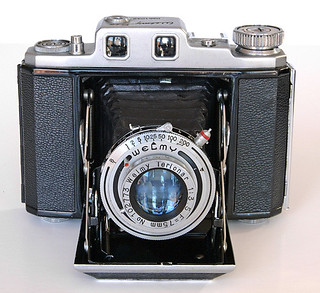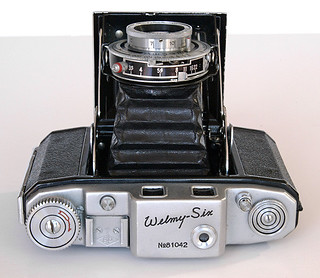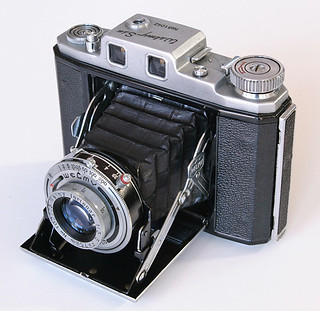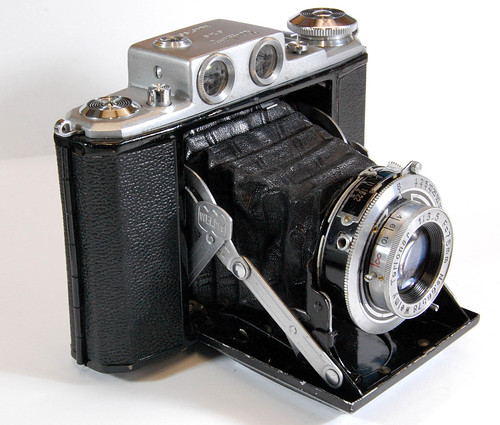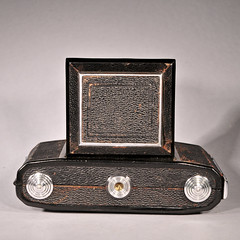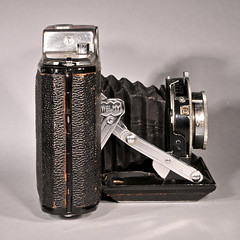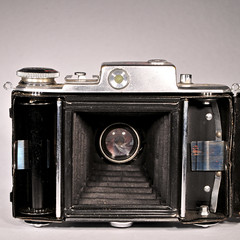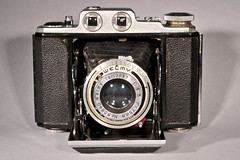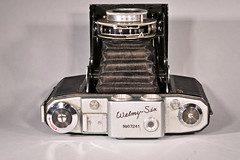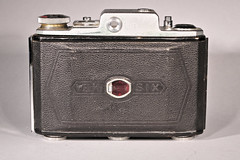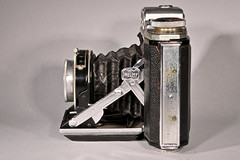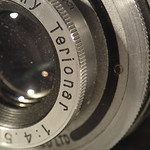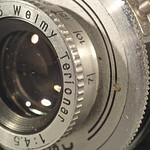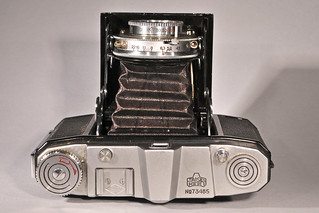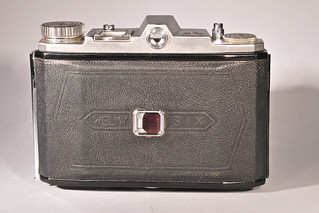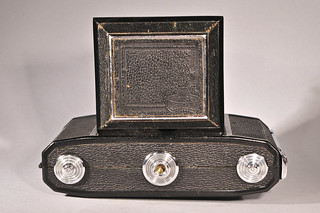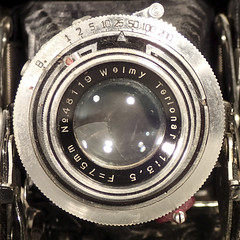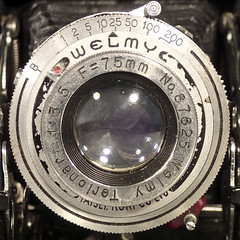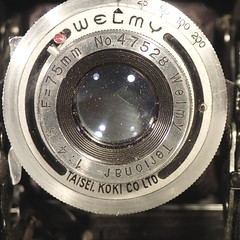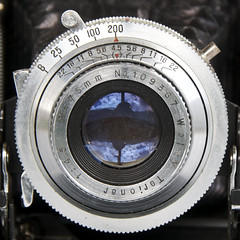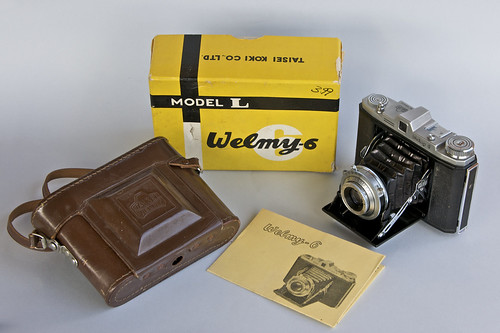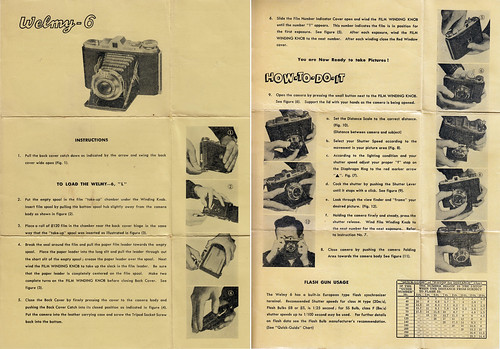The Welmy Six are viewfinder-only 6×6cm folding cameras made by Taisei Kōki. The Mount Six is a name variant of the Welmy Six E, and the Mount Six III is a version with an uncoupled rangefinder. The cameras appeared on the Japanese market in 1951, produced under the name Narikō (abbreviated from Narimasu Kōki), one of the parent companies of Taisei Kōki. According to Sugiyama Taisei Kōki coded its 6x6 folder types based on the letters of its name (W-E-L-M-Y), but went out of business at the time model M was being designed.[1]
Between 1951 and 1953 three models were produced (W, E, L), all of which were 6x6 folders. While the top housing and the lens shutter assemblies changed, the body shell remained the same, minor cosmetic changes to film spool release buttons notwithstanding. It is surprising that Taisei Koki bucked the general trend of the time and did not upgrade the Welmy to a bi-format camera (6x6 and 4.5x6) with barn door style film frame restrictors.
There are no confirmed data on the total production of Welmy folders, but high production numbers are indicated by the frequency with which Welmy Six cameras appear in on-line auctions in Japan and Europe/USA.[2]
Welmy-Six
The original Welmy Six (Model -W) is a horizontal strut folder for 6x6 images on 120 rollfilm. The camera has an asymmetrical Chrome or RARE black top housing with two prominent, circular viewfinder windows at the front, which explain its colloquial name of 'Welmy Frogeyes.' In addition, Welmy Used Green filters that give the circular viewfinders a green glow. Thus; "Frogeyes". The left window (seen from the photographer) is a true viewfinder, while the right is a Brillant-type viewfinder. Unlike contemporary cameras, like the Mamiya Six, the corresponding Brillant-type viewfinder window on top of the housing is extremely small and, for practical purposes, quite useless. The top of the viewfinder housing shows the camera name.
To the left of the viewfinder housing are the film advance knob, an accessory shoe and the button for the front door release. To the viewfinder housing is the shutter release as well as an ornamental covering for the film spool holder.
The Welmy uses a three-component strut system patterned along the line of the Ikonta with a small thumb panel.
The ends of the top housing have two loops to allow a neck strap to be attached. There is a single red window (with sliding cover) on the back, flanked by the text WELMY SIX embossed into the leatherette.
The camera came equipped with a Terionar f/3.5 75mm with front cell focussing.
early version
The top of the viewfinder housing shows the camera name 'Welmy' without a serial number or a model indication. The camera has a Narikō metal name tag affixed on the front left.
The small panel at the hinge of the struts also shows the name 'Narikō'.
Variants
Two variants have been observed set out in chronological order (based on the progression of lens serial numbers):
- with Narikō Terionar f/3.5 75mm with black bezel in Narikō shutter (T, B, 1-250). The edges of the view finder window on the top shows fine serrations.[3]
- with Nari-kō Terionar f/3.5 75mm in fine pitched front cell focus design, with black bezel in Narikō shutter (T, B, 1-200). The top of the viewfinder housing only shows the word 'Welmy 6x6' with a serial number. The camera has a Nariko metal name tag affixed on the front left. The edges of the view finder window on the top shows fine serrations.[4]
late version
The late version was released in 1953. The top of the viewfinder housing shows the camera name Welmy 6x6 and the serial number, with the word 'Welmy' set in cursive script.
The small panel at the hinge of the struts shows the name 'WELMY'.
Variants
Two variants have been observed set out in chronological order (based on the progression of serial numbers):
- with Terionar f/3.5 75mm with black bezel in unnamed shutter (B, 1-200). The edges of the view finder window on the top shows fine serrations.[5]
- with Terionar f/3.5 75mm with silver bezel in Welmy shutter (B, 1-200).The edges of the view finder window on the top is smooth. Some of these models have an EP marking on the flash shoe.[6]
Welmy Six E
The Welmy Six E is a development of the original model, released in 1953. The lines of the top housing are more rounded giving he camera a less clunky appearance. The viewfinder windows up front are smaller, and have a square cross-section, even though they are surrounded by circular covers.[7] The model name on the top housing now states 'Welmy-Six', all in cursive script.
The two loops, to allow a neck strap to be attached, have been omitted from the ends of the top housing.
As it's predecessor, the camera came equipped with a Terionar f/3.5 75mm with front cell focussing.
Variants
A number of variants have been observed:
- Variant A with circular viewfinder surrounds with Terionar f3.5 75mm in Taisei Koki Welmy shutter (B, 1-200).[8]
- Variant B with angular viewfinder surrounds with Terionar f3.5 75mm in Taisei Koki Welmy shutter (B, 1-200). Some of these models have an EP marking on the flash shoe.[9]
Welmy Six L
Released in late 1953, the Welmy Six L represents an overhaul and visual modernisation of the camera in line with competitors at the time. It now sports a a slim top housing with a single central viewfinder window, framed by the camera name at the left (as seen from the photographer) and to speed lines at the right. The top housing has the same mechanical layout as the previous models. To the right of the viewfinder are the company logo as well as the serial number. The small panel on the strut system shows the Taisei logo with the text TAISEI WELMY. The serial number sequence seems to be restarted for this model, possibly at 10000. According to Sugiyama, the camera could be obtained in black, red and green leatherette.[10]
Like the previous models, the Welmy Six L is fitted with a Welmy Terionar 75mm but with the slower f/4.5 and also set in lesser Welmy shutter (B, 25-200).
Variants
The Welmy Six L exists in three minor variants, distinguishable by the lens bezel:
Variant A: The focussing ring of the Terionar lens has fine serrations.[11]
Variant B:The focussing ring of the Terionar lens has coarse serrations. Lens set in a Welmy shutter. Some of these models have an EP marking on the flash shoe [12]
Variant C:The focussing ring of the Terionar lens has coarse serrations. Lens set in an unnamed shutter.[13]
Shutters and Lenses
An examination of a range of Welmy cameras shows the following range of lenses and shutters, arranged in chronological order (based on body serial numbers):
Instructions and Shop Boxes
Notes
- ↑ Sugiyama p. 97 nº 1434.
- ↑ If the maximum overall serial number spans are to be believed, then about 100,000 units of Welmy Six W and E and another 100,000 of Welmy Six L have been produced. That total volume appears unlikely.
- ↑ Documented serial number range below 10xxxx.
- ↑ Documented serial number range 10xxxx. Green tinted windows in View finder and reflex finder, sometimes called "Green frog-Eyes",model. Made in occupied Japan stamped in back door below sliding cover of red window.*****"Early Version"- One known Model W just engraved Welmy in script in all black enamel (OEM?)on top deck with brillant Green Frog-Eyes No.20,732 on lens Nari-ko Terinar 75mm/3.5 in Nariko shutter T,B,1~250th-Front cell focus D.O.F. scale is in Meters;no body serial #,accesory shoe missing;owner Eastwestphoto-2/24/2015****http://www.flickr.com/photos/59361781@N03/16609299256/
- ↑ Documented serial number range 12xxx to 28xxx.
- ↑ Documented serial number range 34xxx to 51xxxx.
- ↑ Sugiyama erroneously labels the Taisei version of the Welmy-W as Welmy E (p. 97, nº 1434).
- ↑ Documented serial number range 67xxx to 74xxx.
- ↑ Documented serial number range 80xxx to 98xxx.
- ↑ Sugiyama p. 97 nº 1436.
- ↑ Documented serial number range 12xxx to 56xxxx.
- ↑ Documented serial number range 72xxx to 76xxx.
- ↑ Documented serial number range 105xxxx.
Bibliography
- Asahi Camera (アサヒカメラ) editorial staff. Shōwa 10–40nen kōkoku ni miru kokusan kamera no rekishi (昭和10–40年広告にみる国産カメラの歴史, Japanese camera history as seen in advertisements, 1935–1965). Tokyo: Asahi Shinbunsha, 1994. ISBN 4-02-330312-7. Items 395–7 and 845.
- Lewis, Gordon, ed. The History of the Japanese Camera. Rochester, N.Y.: George Eastman House, International Museum of Photography & Film, 1991. ISBN 0-935398-17-1 (paper), 0-935398-16-3 (hard). P.83.
- McKeown, James M. and Joan C. McKeown's Price Guide to Antique and Classic Cameras, 12th Edition, 2005-2006. USA, Centennial Photo Service, 2004. ISBN 0-931838-40-1 (hardcover). ISBN 0-931838-41-X (softcover). Pp.910–1.
- Omoide no supuringu-kamera-ten (思い出のスプリングカメラ展, Exhibition of beloved self-erecting cameras). Tokyo: JCII Camera Museum, 1992. (Exhibition catalogue, no ISBN number.) P.27.
- Sugiyama, Kōichi (杉山浩一); Naoi, Hiroaki (直井浩明); Bullock, John R. The Collector's Guide to Japanese Cameras. 国産カメラ図鑑 (Kokusan kamera zukan). Tokyo: Asahi Sonorama, 1985. ISBN 4-257-03187-5. Items 1366 and 1433–7.
Links
In English:
In Japanese:
In French:
